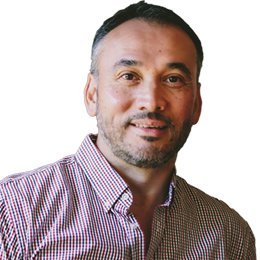Meet CO-ADD's Dr Karl Hansford
Karl Hansford is CO-ADD's lead medicinal chemist involved in hit confirmation and validation
What is your research about? How is it connected to the IMB Centre For Superbug Solutions?
My research in the Cooper group attempts to tackle some of the most fundamental challenges in antibiotic discovery: how do antibiotics work, how can we make existing treatments better, and how can we discover new molecules to overcome the development of bacterial resistance. The dilemma of antibiotic resistance has far reaching implications beyond the scientific community. Consequently, research in the Cooper group generates many fruitful collaborations across academia, industry, government, and medicine despite its humble academic origin. Collectively, we are all working toward the common goal of eradicating superbugs, which is the overarching focus of the IMB Centre for Superbug Solutions. Conducting research at the forefront of antibiotic discovery is as exciting as it is challenging; no two days are alike, and this provides inspiration to persevere in the face of many unanswered questions!
As a synthetic chemist, I use medicinal chemistry approaches to try and improve our understanding of antibiotics and the empirical rules that govern their behavior. I work on a range of projects designed to either elucidate antibiotic mode of action, improve existing treatments, re-discover ‘forgotten’ antibiotics, or discover new starting points for antibiotic design. Our projects range in maturity from basic discovery through to commercial application.
For example, we have developed a next-generation glycopeptide antibiotic known as Vancapticin through strategic chemical modification of the legacy compound vancomycin, resulting in the successful restoration of its activity against drug-resistant strains of Gram-positive bacteria. With funding from an NHMRC development grant, we are now progressing our compounds through lead optimization toward a preclinical drug candidate. We also have an NIH funded program targeting the ESKAPE human pathogens with synthetic polymyxin analogues; total synthesis is used to construct these cyclic lipopeptides allowing us to rationally modify them with high fidelity. Using this approach, we have identified compounds with potent activity against strains of Gram-negative bacteria that are otherwise completely resistant toward colistin and polymyxin B, two clinical drugs considered last resort options for refractory bacterial infections.
What is your role in the CO-ADD project?
I am the lead medicinal chemist involved in hit confirmation and validation. As we identify hits from compound collections sent to us from our worldwide network of collaborators, my job is to assess the chemistry surrounding any identified hits as a means to warrant further study. Once a hit has progressed through the CO-ADD screening workflow, in the process confirming identity, purity, bona fide activity and metabolic stability, there are many aspects of a molecule’s chemistry that require assessment. Promising hits have to satisfy a number of criteria such as synthetic tractability (a candidate molecule becomes less attractive as the complexity and cost of its synthesis increases), novelty (is IP crowded?), solubility (poor solubility/high lipophilicity are poor starting points for lead optimization), and chemical stability. Antibiotics often contain unique functional groups that would be considered non drug-like; a dogma of medicinal chemistry screening programs is to eliminate such compounds upfront. On the contrary, we do not automatically eliminate such compounds from our screening sets, instead evaluating unusual functional groups on a case-by-case basis according to the presence/absence of common toxicophores, metabolic liabilities, and groups known to frequently hit biological targets indiscriminately.
It is very common during screening campaigns to observe biological activity that cannot be reproduced with a new batch of compound owing to highly active impurities in the original screening sample or some other confounding factor. In some instances it is also possible that systematic structural modification of the hit compound does not substantially affect biological activity (know
n as flat SAR), alerting to the possibility that such compounds may not be optimizable. With this in mind, it is my responsibility to assess our hits by re-purifying or re-synthesizing them to ensure that the initial screening results can be reproduced. Assuming activity can be reproduced, I am then tasked with designing and synthesizing sets of structural analogues to assess if meaningful structure-activity data be obtained for a particular series.
The chemistry data thus produced contributes to a data package that is provided to the submitter of the compound so that they may decide if their compound(s) are worthy of further chemistry optimization.
What's happening now for CO-ADD?
Right now, it is an exciting time for CO-ADD, with 50,000 compounds having just arrived this week from a consortium of French research institutes. We also currently receive a steady stream of 4000/month from Russia, which will continue up until the end of 2018 (a total of 150,000 compounds!). We are in a very fortunate position to have significant engagement from the worldwide chemical community, and being inundated with compounds is a good ‘problem’ to have!
Dr Karl Hansford's background
My PhD in organic chemistry was completed in 2000 at The University of Queensland. After a brief postdoctoral stint in medicinal chemistry here at the IMB, I ventured to the US and Canada to complete postdoctoral appointments in organic synthesis/peptidomimetic chemistry at the University of Pittsburgh and the Université de Montréal. Thereafter, I joined Mimetogen Pharmaceuticals (Montréal) where I oversaw the medicinal chemistry program developing peptidomimetics as a platform for neurotrophin mimicry. In 2007 I returned to Australia to lead the R&D team developing novel process methodology for the commercial scale production of boronic acids at Boron Molecular in Melbourne. In 2011, with a compulsion to join an influential medicinal chemistry team, I returned to Brisbane to join the Cooper group, where I am now senior research officer and lead medicinal chemist for several projects.
